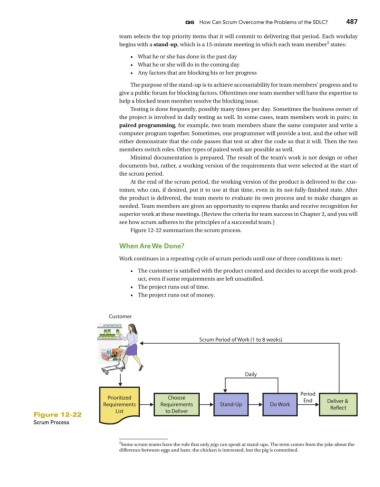Page 519 - Using MIS
P. 519
Q6 How Can Scrum Overcome the Problems of the SDLC? 487
team selects the top priority items that it will commit to delivering that period. Each workday
5
begins with a stand-up, which is a 15-minute meeting in which each team member states:
• What he or she has done in the past day
• What he or she will do in the coming day
• Any factors that are blocking his or her progress
The purpose of the stand-up is to achieve accountability for team members’ progress and to
give a public forum for blocking factors. Oftentimes one team member will have the expertise to
help a blocked team member resolve the blocking issue.
Testing is done frequently, possibly many times per day. Sometimes the business owner of
the project is involved in daily testing as well. In some cases, team members work in pairs; in
paired programming, for example, two team members share the same computer and write a
computer program together. Sometimes, one programmer will provide a test, and the other will
either demonstrate that the code passes that test or alter the code so that it will. Then the two
members switch roles. Other types of paired work are possible as well.
Minimal documentation is prepared. The result of the team’s work is not design or other
documents but, rather, a working version of the requirements that were selected at the start of
the scrum period.
At the end of the scrum period, the working version of the product is delivered to the cus-
tomer, who can, if desired, put it to use at that time, even in its not-fully-finished state. After
the product is delivered, the team meets to evaluate its own process and to make changes as
needed. Team members are given an opportunity to express thanks and receive recognition for
superior work at these meetings. (Review the criteria for team success in Chapter 2, and you will
see how scrum adheres to the principles of a successful team.)
Figure 12-22 summarizes the scrum process.
When Are We Done?
Work continues in a repeating cycle of scrum periods until one of three conditions is met:
• The customer is satisfied with the product created and decides to accept the work prod-
uct, even if some requirements are left unsatisfied.
• The project runs out of time.
• The project runs out of money.
Customer
Scrum Period of Work (1 to 8 weeks)
Daily
Period
Prioritized Choose End
Requirements Requirements Stand-Up Do Work Deliver &
List to Deliver Reect
Figure 12-22
Scrum Process
5 Some scrum teams have the rule that only pigs can speak at stand-ups. The term comes from the joke about the
difference between eggs and ham: the chicken is interested, but the pig is committed.

